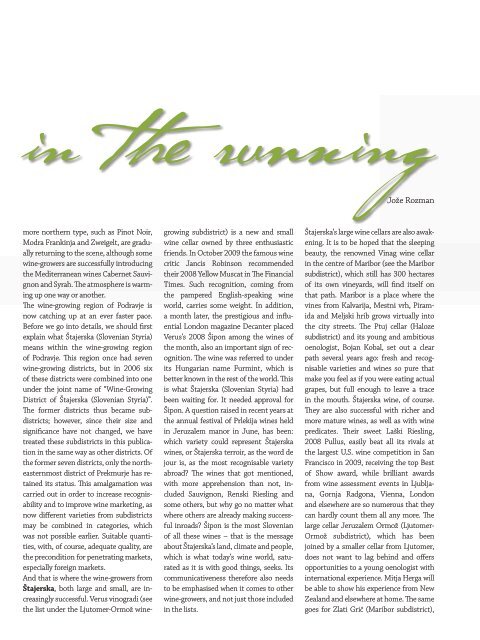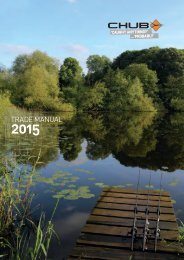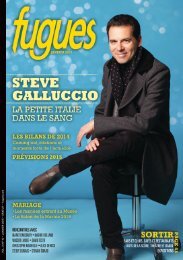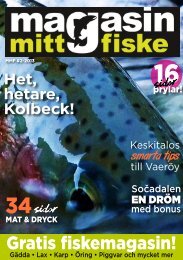SLOVENIAN WINE ROADS
“We eat and drink to live! But we don’t live to eat and drink!“ That‘s what the adage says, telling us that both wine and food are consequences of man‘s economic endeavours, a form of social cohesion and a reflection of the immense variety of cultural creativity. That is why it is through wines and dishes that we can recognise life styles, ordinary days and holidays, the efforts of individuals, families and inhabitants of towns, villages and regions. Through this publication we invite you to discover the richness of all three wine-growing regions of Slovenia, which, with its hundreds of years of cultural entanglements, is building its modern recognisability at the junction of the European Alps, the Mediterranean and the Pannonian Plain. It is this very junction that also gives a special and recognisable character to all of our wines and cuisine. Our numerous, often quite boutique and extremely natural wines, include quite a few original or autochthonous specialties, which, along with other wines, can very quickly create unique experiences and relationships for you. Here the path from heart to soul is a very short one... That is exactly why we are offering you several wine routs, which will lead you through the wine-growing regions of Podravje, Posavje and Primorska... To good people and dishes and to noble wines!
“We eat and drink to live! But we don’t live to eat and drink!“ That‘s what the adage says, telling us
that both wine and food are consequences of man‘s economic endeavours, a form of social cohesion
and a reflection of the immense variety of cultural creativity. That is why it is through wines
and dishes that we can recognise life styles, ordinary days and holidays, the efforts of individuals,
families and inhabitants of towns, villages and regions. Through this publication we invite you
to discover the richness of all three wine-growing regions of Slovenia, which, with its hundreds
of years of cultural entanglements, is building its modern recognisability at the junction of the
European Alps, the Mediterranean and the Pannonian Plain. It is this very junction that also gives
a special and recognisable character to all of our wines and cuisine. Our numerous, often quite
boutique and extremely natural wines, include quite a few original or autochthonous specialties,
which, along with other wines, can very quickly create unique experiences and relationships for
you. Here the path from heart to soul is a very short one... That is exactly why we are offering you
several wine routs, which will lead you through the wine-growing regions of Podravje, Posavje and
Primorska... To good people and dishes and to noble wines!
Create successful ePaper yourself
Turn your PDF publications into a flip-book with our unique Google optimized e-Paper software.
in the running<br />
more northern type, such as Pinot Noir,<br />
Modra Frankinja and Zweigelt, are gradually<br />
returning to the scene, although some<br />
wine-growers are successfully introducing<br />
the Mediterranean wines Cabernet Sauvignon<br />
and Syrah. The atmosphere is warming<br />
up one way or another.<br />
The wine-growing region of Podravje is<br />
now catching up at an ever faster pace.<br />
Before we go into details, we should first<br />
explain what Štajerska (Slovenian Styria)<br />
means within the wine-growing region<br />
of Podravje. This region once had seven<br />
wine-growing districts, but in 2006 six<br />
of these districts were combined into one<br />
under the joint name of “Wine-Growing<br />
District of Štajerska (Slovenian Styria)”.<br />
The former districts thus became subdistricts;<br />
however, since their size and<br />
significance have not changed, we have<br />
treated these subdistricts in this publication<br />
in the same way as other districts. Of<br />
the former seven districts, only the northeasternmost<br />
district of Prekmurje has retained<br />
its status. This amalgamation was<br />
carried out in order to increase recognisability<br />
and to improve wine marketing, as<br />
now different varieties from subdistricts<br />
may be combined in categories, which<br />
was not possible earlier. Suitable quantities,<br />
with, of course, adequate quality, are<br />
the precondition for penetrating markets,<br />
especially foreign markets.<br />
And that is where the wine-growers from<br />
Štajerska, both large and small, are increasingly<br />
successful. Verus vinogradi (see<br />
the list under the Ljutomer-Ormož wine-<br />
growing subdistrict) is a new and small<br />
wine cellar owned by three enthusiastic<br />
friends. In October 2009 the famous wine<br />
critic Jancis Robinson recommended<br />
their 2008 Yellow Muscat in The Financial<br />
Times. Such recognition, coming from<br />
the pampered English-speaking wine<br />
world, carries some weight. In addition,<br />
a month later, the prestigious and influential<br />
London magazine Decanter placed<br />
Verus’s 2008 Šipon among the wines of<br />
the month, also an important sign of recognition.<br />
The wine was referred to under<br />
its Hungarian name Furmint, which is<br />
better known in the rest of the world. This<br />
is what Štajerska (Slovenian Styria) had<br />
been waiting for. It needed approval for<br />
Šipon. A question raised in recent years at<br />
the annual festival of Prlekija wines held<br />
in Jeruzalem manor in June, has been:<br />
which variety could represent Štajerska<br />
wines, or Štajerska terroir, as the word de<br />
jour is, as the most recognisable variety<br />
abroad? The wines that got mentioned,<br />
with more apprehension than not, included<br />
Sauvignon, Renski Riesling and<br />
some others, but why go no matter what<br />
where others are already making successful<br />
inroads? Šipon is the most Slovenian<br />
of all these wines – that is the message<br />
about Štajerska’s land, climate and people,<br />
which is what today’s wine world, saturated<br />
as it is with good things, seeks. Its<br />
communicativeness therefore also needs<br />
to be emphasised when it comes to other<br />
wine-growers, and not just those included<br />
in the lists.<br />
Jože Rozman<br />
Štajerska’s large wine cellars are also awakening.<br />
It is to be hoped that the sleeping<br />
beauty, the renowned Vinag wine cellar<br />
in the centre of Maribor (see the Maribor<br />
subdistrict), which still has 300 hectares<br />
of its own vineyards, will find itself on<br />
that path. Maribor is a place where the<br />
vines from Kalvarija, Mestni vrh, Piramida<br />
and Meljski hrib grows virtually into<br />
the city streets. The Ptuj cellar (Haloze<br />
subdistrict) and its young and ambitious<br />
oenologist, Bojan Kobal, set out a clear<br />
path several years ago: fresh and recognisable<br />
varieties and wines so pure that<br />
make you feel as if you were eating actual<br />
grapes, but full enough to leave a trace<br />
in the mouth. Štajerska wine, of course.<br />
They are also successful with richer and<br />
more mature wines, as well as with wine<br />
predicates. Their sweet Laški Riesling,<br />
2008 Pullus, easily beat all its rivals at<br />
the largest U.S. wine competition in San<br />
Francisco in 2009, receiving the top Best<br />
of Show award, while brilliant awards<br />
from wine assessment events in Ljubljana,<br />
Gornja Radgona, Vienna, London<br />
and elsewhere are so numerous that they<br />
can hardly count them all any more. The<br />
large cellar Jeruzalem Ormož (Ljutomer-<br />
Ormož subdistrict), which has been<br />
joined by a smaller cellar from Ljutomer,<br />
does not want to lag behind and offers<br />
opportunities to a young oenologist with<br />
international experience. Mitja Herga will<br />
be able to show his experience from New<br />
Zealand and elsewhere at home. The same<br />
goes for Zlati Grič (Maribor subdistrict),

















